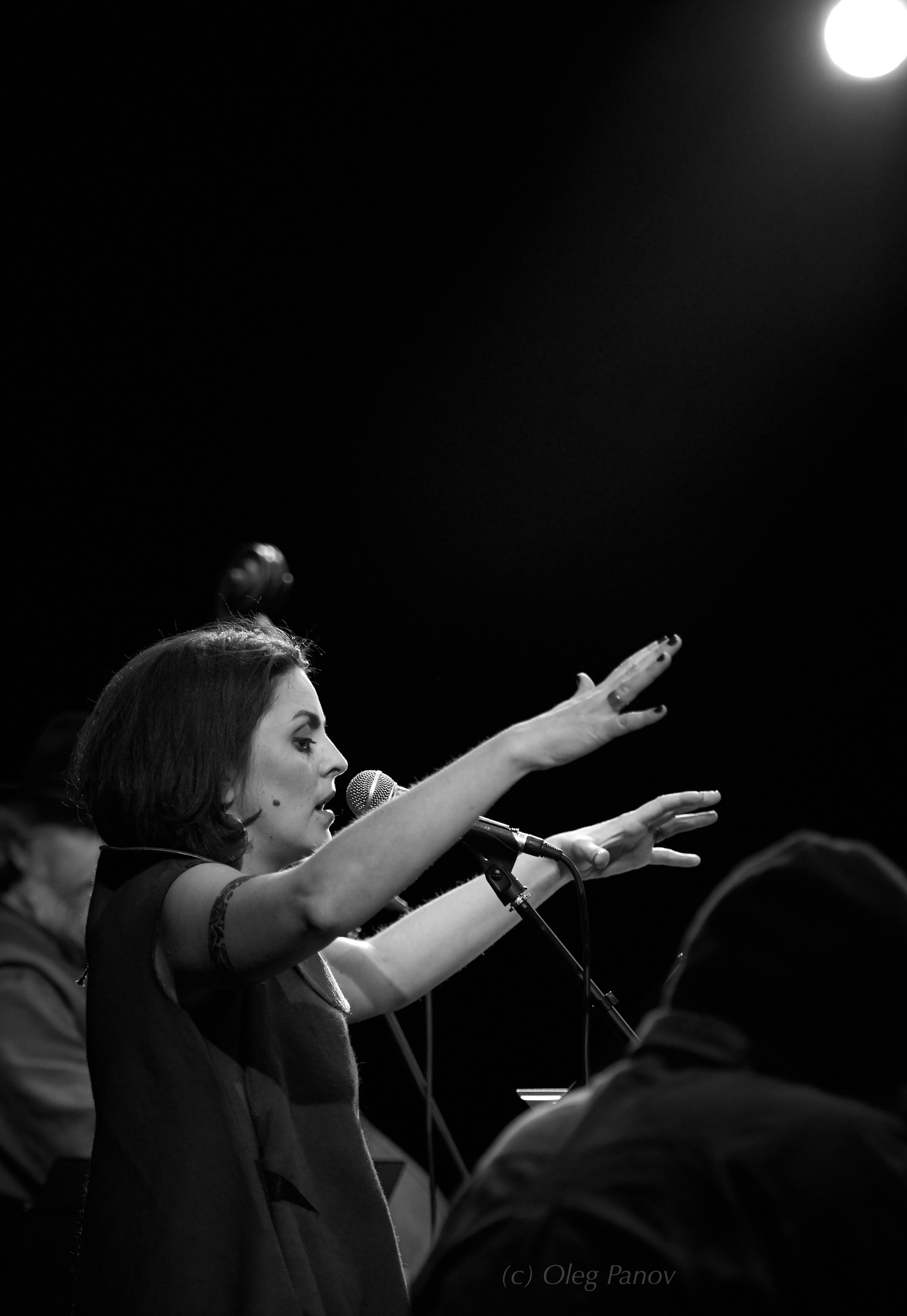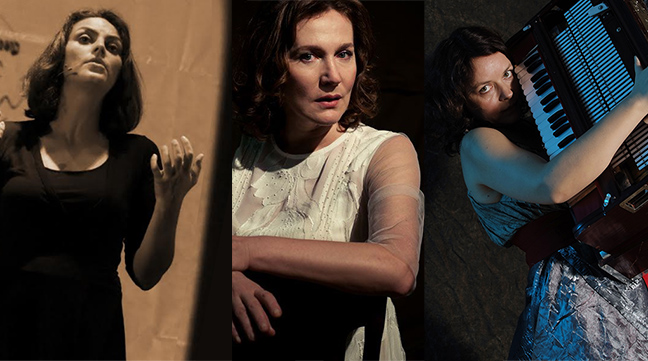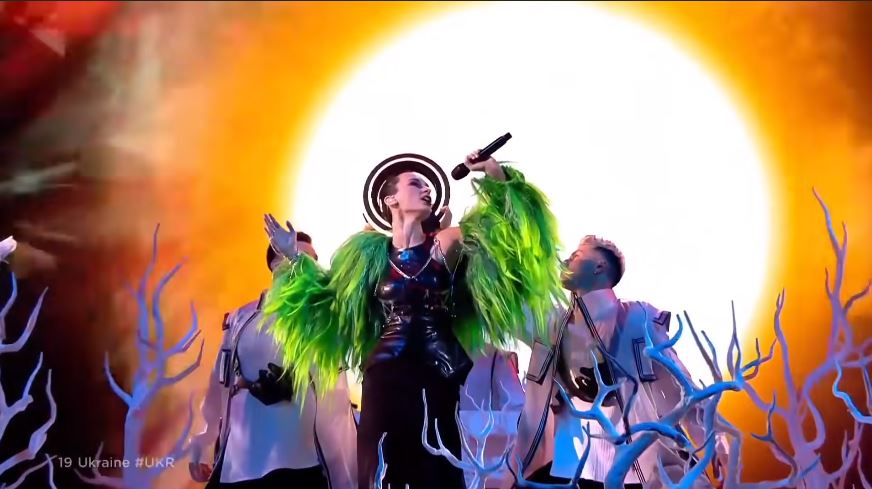In and around the western Ukrainian city of Lviv, there has arisen in the post-Soviet era a trio of creative musical figures of an exceedingly singular character.
All three, as it happens, are women. And though Ukraine is hardly known as a bastion of Feminism, these three Ukrainian women—Mariana Sadovska, Natalia Polovynka and Ulyana Horbachevska—have together forged such a distinctively innovative path (whatever their marked differences from one another), that they cannot be considered as anything less than crucial artistic groundbreakers, of the sort that not so long ago was quite rare for women from any nation.
And the artistic expression that arises from such attempts not only forms a significant part of Ukrainian musical and cultural history, it at the same time bears within itself valuable lessons, imparting illuminating wisdom concerning the role that Tradition can play in all our lives, stranded as we are amidst the impasse that is contemporary existence.
It should at once be stipulated, however, that this distinctive view on Tradition’s possibilities, inherent in the work of these three Ukrainian women, turns away from Tradition’s more rigidifying characteristics—its propensity to compel thoughtless conformity to outworn ways of life, such that can stifle and constrain human individuals.
Instead, what I believe is at hand in these women’s work is an approach towards Tradition that tries to elicit from it a revivification of ancient patterns of human interaction, of emotional and psychological connection, and adaptation to human predicaments, that can confer profound meaning and orientation to our lives today.

What this article wants to closely consider is not simply “Tradition” in the general or abstract sense, though, but rather the specific “tradition” of Ukrainian authentic music. It is this authentic music culture that all three of these artists have alike apprenticed themselves to and grounded their art on. And while there are without doubt pronounced differences in how these three each engage with this tradition, there are also very strong connecting threads that run between them.
Hence: all three draw an appreciable amount of inspiration, and also musical materials, from the same authentic music wellspring—the small central Ukrainian village of Kryachkivka (a tiny locale that has played an outsized role in the “authentic music revival movement” in Ukraine)—and furthermore adopt strategies of engaging with such authentic sources that are influenced by the same line of European avant-garde theatre methodology.
Drevo: where it all started
But it is Mariana Sadovska, as far as being a pioneer goes, who would need to be seen here as “first among equals”, for it she who laid down the foundations for the broad path that all three of these artists have explored in their differing ways.
It was Sadovska, that is to say, who first brought together this combination of European avant-garde theatre methodology and Ukrainian authentic music culture.
By her own account, this occurred very early in her career—in the year 1991—when at a moment in which she was just beginning her long relationship with the world of European avant-garde theatre, she heard for the first time the music of Drevo, the first “professional” authentic music group in Ukraine. Founded in 1979 by the Kyiv Conservatory ethnomusicologist Yevhen Yefremov, Drevo (the word means “tree” in Ukrainian) went on to serve as the primary blueprint for the whole plethora of authentic music groups that would sprout up in Ukraine in subsequent years.
Yet Drevo’s history is quite a bit more complicated, and quite a bit older, than this standard account indicates: The origins of the ensemble actually hark back to 1958, when another Kyiv Conservatory ethnomusicologist, Volodymyr (Vladimir) Matviyenko, first discovered the aforesaid village of Kriachkivka.
What Matviyenko found in this tiny Poltavshchyna village was a circle of friends—most of them again, women—who without any outside encouragement or support, were endeavoring to preserve the exquisite vocal traditions that had been rooted in this region since time immemorial.
And it was primarily as a result of Matviyenko’s ensuing involvement with Kriachkivka—initiating thereby a collaborative relationship between himself and his coterie of academic acolytes on the one hand, and the music-making residents of the village on the other—that the latter decided in 1960 to organize themselves, now on somewhat more formal terms, as a performing unit that they would come to call “Drevo,” after one of their own signature songs.
Participants of the Drevo (Kriachkivka) ensemble sing their signature song "Drevo" for a folklore expedition
This version of Drevo, however—which might be referred to as “Drevo (Kriachkivka)”—did not at first venture much beyond its own rural outpost. And given the stultifying, prohibitive conditions that were endemic under the Soviet regime, it was not exactly what could be recognized as a “professional” group, either.
So it was only when Yevhen Yefremov, with Matviyenko’s support, launched his urban-based ensemble in 1979, made up of his own academic acolytes, which he would also come to designate as “Drevo”—and that might be referred to then as “Drevo (Kyiv)”—that something more closely resembling a “professional” authentic music ensemble in Ukraine was born (in so far as glacially-changing circumstances in the Soviet Union now grudgingly allowed for such a thing).
The Drevo Kyiv ensemble under the leadership of Yefremov sings the song "Oxen" from the Poltava region
And not only did Yefremov’s ensemble derive a decent portion of its initial repertoire from musical materials, as well as performance practices learnt at Kriachkivka, its whole foundational basis really grew out of the “collaborative relationship model” between urban academics, and the living rural embodiments of Ukraine’s authentic music culture that Volodymyr Matviyenko inaugurated back in 1958, and that has functioned as the basis of the Ukrainian “authentic music revival movement” ever since.
Mariana Sadovska

And it was actually a recording of Drevo (Kriachkivka), and not Drevo (Kyiv), that Sadovska heard in 1991—although it was a “field recording” made by members of Drevo (Kyiv), played for her at a get-together at their house in Kyiv (and in a sense, this itself could stand as one exemplar of the “collaborative relationship” between these two versions of Drevo).
And the decisive step that Sadovska took, then, soon after first encountering the music of Drevo, was to effectively merge this “collaborative relationship model,” employed in Ukraine by Matviyenko/ Yefremov, with a quite similar “model” (albeit also quite dissimilar in certain critical ways) that was in operation within exactly those precincts of the European avant-garde theatre world in which she had just become a participant.
The two avant-garde theatre figures to take note of in this respect—both of Polish origin—are Jerzy Grotowski and Włodzimierz Staniewski.
Both Grotowski (who was altogether one of the most influential director/theorists to have emerged in European theatre since the Second World War), and Staniewski (who at an early point in his career was a “close associate of Grotowski”) put great emphasis on doing “fieldwork” in remote areas of the world, with the objective of passionately interconnecting with, and learning from, the still-surviving representatives of traditional culture that might be found there.
And thus, as a result perhaps of shared roots in practices long prevalent in both anthropology and ethnomusicology, what Grotowski/Staniewski were up to along these lines in their own sphere of endeavor—European avant-garde theatre—was fairly well analogous, mutatis mutandis, to what Matviyenko/ Yefremov were up to in theirs—Ukrainian authentic music.
It might be seen as just about inevitable, therefore, that the Ukrainian born-and-bred Sadovska—who at the moment that she first heard Drevo, had just completed a stint with Grotowski’s “Slavic Pilgrim Project,” and soon thereafter joined up for a decade-long stretch with Staniewski’s Gardzienice Centre for Theatre Practices—would upon becoming acquainted with the phenomenon of “Drevo-Kryachkivka,” move to integrate this into the avant-garde theatre world she was now taking part in.
Yet to put the matter in these perfunctory terms might have the unfortunate effect of downplaying the overwhelming impression that Drevo’s music, with its extraordinary power of unadorned simplicity, made on her at that moment in 1991.
Whatever the case, Sadovska started doing “fieldwork”—which is to say, song collecting—shortly thereafter in Ukraine, starting in 1992, and went on in 1993 to make her first “pilgrimage” to Kryachkivka itself, where she initiated a close, long-standing “collaborative relationship” with the music makers there.
And this experimental element was consequential—within the wider environs of the authentic music movement, certainly, and probably within the whole of Ukrainian music, too—not merely because it encouraged many interesting explorations on the part of many different artists, but more importantly, because it brought out depths and complexities (again, largely inspired at the outset by Grotowski/Staniewski) of a kind that might not have otherwise come forth.
For what both Grotowski and Staniewski were attempting to do was to penetrate to the heart core of traditional ways of life, and to do so by means that, by necessity, reached far beyond the conventional, mundane, habitual behaviors of the present day.
What these two avant-garde theatre theorists were aiming for, in other words, was to stir back into being a vital, immediate apprehension of the “fundamental structures”—“mythic forms” or “archetypes”—that lay at the base of traditional ways, such that are given voice to in ritual and other expressive modalities, and which in this manner, are available to everyone.
Such “fundamental structures”—as bare, essential forms—have little place in our industrialized, and post-industrialized epoch, however. It was thus the thinking of both Grotowski and Staniewski that these “structures” can perhaps best be reawoken through the sort of intense bodily exertions, and intense concentrations of psychic energy, that experimental theatrical research is willing to dedicate itself to.
And it is possibly through such means, too, that these “fundamental structures” can best find a way to be reinstated, re-situated within the gnarled, convoluted architecture of contemporary life.
How this whole theoretical approach concretely impacts on Sadovska’s art, and how it is interwoven into her renditions of Ukrainian traditional music, should be a matter easily grasped by anyone at all familiar with her body of work, as such intense exertions and concentrations of energy, and concomitant revelations of archetypal forms of expression, permeate such a large portion of it.
Maisternia Pisni and Natalia Polovynka

Whether it was a matter of direct or indirect, conscious or unconscious influence, the foundations that Mariana Sadovska set down, in bringing together these two domains of Ukrainian authentic music and European avant-garde theatre, then formed a kind of starting point for another group of artists associated with the city of Lviv—even though it must be said, this group would go on to venture into areas very much at variance from Sadovska.
This was Maisternia Pisni, a “music/theatre company” that contained within its ranks both Natalia Polovynka and Ulyana Horbachevska.
Formed in the early Aughts, the group also included as its third primary member Olena Kostyuk. One might be forgiven, therefore, for taking Maisternia Pisni at first glance to be principally a world-class authentic music vocal ensemble.
A second, more sustained look, though, would reveal the group to be much more than this. This is especially evident vis-à-vis its extensive involvement with the world of avant-garde theatre. And this is most of all the case concerning its special concentration on the theoretical side of this world, delving into this perhaps to a greater degree—at least on the surface of things—than Sadovska.
Maisternia Pisni did definitely emerge out of the same line of Polish-based, avant-garde theatre as Sadovska, though. Indeed, both Polovynka, who served as the group’s creative director, and Sergey Kovalevich, who co-led the group with Polovynka as a sort of “resident theorist” (one of his official titles, itself a theatre locution, was “dramaturge”), studied and/or worked with the company of Jerzy Grotowski in Poland.
And even though it was Kovalevich’s theoretical investigations—very much in the spirit of Grotowski—that perhaps most shaped the group’s overall exploratory disposition, it was definitely Polovynka who most of all charted the specific “territories,” so to speak, that the group proceeded to explore.
In regards to some of these “territories,” Maisternia Pisni followed fairly straightforwardly the path that Sadovska had gone down before.
As with Sadovska, then, Maisternia Pisni made its own “pilgrimage” to Kryachkivka, and established its own long-term “collaborative relationship” with the music making residents there—learning from them, but also helping to shape their broader public career in various ways that extend to the present day.
And the manner in which Maisternia Pisni made use of authentic music was also more or less commensurate with Sadovska’s innovative merging of approaches: applying various experimental or at least exploratory methods in interpreting this music, as a means of bringing out unforeseen depths and complexities residing therein.
Yet some of the other “territories” into which Polovynka steered Maisternia Pisni were decidedly different—divergent not just from the work of Sadovska, but in many respects, that of virtually everyone else, too.
What comprised these unusual and even arcane “territories” were Maisternia Pisni’s employment of aspects of age-old religious culture, drawn from the musico-cultural realm of Christian ritual—more specifically, its Eastern Orthodox/Greek Catholic varieties—which were then in some instances commingled with its avant-garde theatre substratum.
Despite the arcane character of these religious aspects, therefore, the strategy of engagement that the group often adopted towards them was not unlike that which it adopted towards authentic music—an experimental or exploratory approach, very much again, in accordance with Grotowski’s theory and practice.
For while this manner of explicit religious concern on the part of Polovynka and Maisternia Pisni was not really a central part of what Grotowski and his associates focused on, it did nonetheless dovetail fairly well into the overall theoretical framework that undergirded the activities of this particular avant-garde theatre milieu.
It was just this, then, that formed the modus operandi of some of Maisternia Pisni’s most definitive work: an exploratory attempt at accessing the “fundamental structures” of the Sacred, by way of methods that derived from the type of experimental theatrical research pursued by Grotowski and his milieu
.
In such work, the “intense concentrations of psychic energy” are actually directed towards the Divine, and the “fundamental structures” are those that aspire to direct communication, or communion, with God.
Yet in a way that organically coalesced—given these common strategies at work—into a single approach, Maisternia Pisni’s rendering of expressly sacred modes of expression was not infrequently blended together with its rendering of authentic music.
So, while some of their work does bear an exclusively religious character, a larger preponderance tends to mix together authentic and sacred strains—thereby often lending a religious coloring to authentic music, and at the same time, bestowing certain qualities of the “authentic music movement” to sacred modes.
In this way, “the sacred” and “the authentic” are mixed together under the mediating aegis of avant-garde theatre methodology, so as to attain to an extraordinarily unique, and perhaps even unprecedented amalgam of approaches and elements.
And it is this incomparably distinctive blend that makes Maisternia Pisni’s work stand out so much, and in such an enduring fashion, too. It is not too much to say, indeed, that under Natalia Polovynka’s creative direction, the group did things that no-one else has done, before or since—whether within Ukraine, or as far as I am aware, anywhere outside the country either.
Having achieved all this in the space of less than a decade, the group then dissolved thereabouts 2011, its members going their own ways.
Natalia Polovynka, notwithstanding, has continued to further explore much the same amalgam of distinctive approaches and elements that she oversaw the construction of as creative director of Maisternia Pisni, but now as director of a new “music/theatre company” called “Word and Voice” (“Slovo i holos”), that she considers in fact to be a direct continuation of Maisternia Pisni.
One of the “territories” she has come to focus on more and more in her post-Maisternia Pisni period—although it played an important part in Maisternia Pisni, too—is a particular form of music that might well stand as Polovynka’s most significant contribution to world music culture.
This is her research and development of “Irmos.”
What can be said here in regards to this, without entering into the question whether she is right or not, is that as a form of musical expression, Polovynka’s “Irmos” music is unequivocally wondrous—somehow vibrantly riveting and unerringly spiritual at the same time, entrancing in its labyrinthine beauty.
Ulyana Horbachevska

Ulyana Horbachevska, then, in her post-Maisternia Pisni career, took her own starting point from the innovations that she helped Maisternia Pisni forge. And in doing so, it can definitely be said that she navigated her way into even newer, and from a certain perspective, even more unique “territories.”
Horbachevska’s art does feature much the same amalgam of approaches and elements that were operative in Maisternia Pisni: There is likewise a strong religious component in her work, and of course a very solid authentic music foundation too, based most of all on the relationship with Kryachkivka that she formed as a member of Maisternia Pisni. And both of these components are again, intermixed with experimental methods derived from or closely related to the Grotowskian milieu.
And the specific musical materials that were peculiar to Maisternia Pisni, such as the “Irmos” music (the research and development of which, while conducted under Polovynka’s direction, she made significant contributions to), are also utilized in Horbachevska’s work.
Yet there is an edgy intensity in Horbachevska’s own interpretation of these materials—and in a good deal of her other work, too—that is not really present all that much in either Maisternia Pisni, or in Polovynka’s post-Maisternia Pisni work.
It is almost as if Horbachevska thus represents a sort of “Hegelian synthesis” between Sadovska’s art—which is certainly inclined to its own moments of “intense edginess,” but lacks a strong religious component—and the deeply religious-imbued art of Polovynka which, although it ascends at times to its own manner of pellucid intensity, rarely if ever involves much in the way of “edginess.”
And the “edgy intensity” that is characteristic of Horbachevska’s work can moreover be asserted to be not simply of performative verve—although it is that, too—but a capacity that with its incandescent emotional ardor, married to true religious feeling, carries along with it a real power to reshape our orientation to the world.
“Edgy intensity” may be declared without question, therefore, as one of the chief keynotes of this artist. Another I think would be “fearlessness”—the avid willingness of Horbachevska to voyage into realms that many other artists would not dare.
Of course, it’s one thing to be fearless—many inept artists are fearless—and another to be successful in what one ventures. Up to this moment in her career at least, even Horbachevska’s more risky ventures have proven artistic successes.
The best example of this would probably be the “Ultramarine” project that Horbachevska took part in with a cadre of Europe’s finest experimental Jazz musicians—this included Lithuania’s Petras Vyšniauskas on soprano saxophone, Germany’s Klaus Kugel on percussion, and Ukraine’s own Mark Tokar on the doublebass.
This utterly unique project amounts to a fusion of Free Jazz experimentalism—music that is not merely improvisational in some of its segments, but wholly open-ended, devised entirely within the moment all throughout—that Vyšniauskas, Kugel and Tokar bring to the proceedings, with the deep-rooted strains of Ukrainian authentic music—some of them tracing back into the hoary mists of antiquity—that Horbachevska brings.
There is therefore an extraordinary coming-together in this project of deep Tradition and what in a sense can even be seen as a sort of anti-Tradition:
What is at work here, in other words, is an imperative on the part of the latter—as put forward by Vyšniauskas, Kugel, and Tokar—to create sheerly on the basis of the here and now, detached as much as possible from already-established habits of practice, and an imperative on the part of the former—as put forward by Horbachevska—to submerge fully and unreservedly into the ancient depths of established Tradition, in search of the archetypal forms of expression—“fundamental structures”—that might be found there.
And this Free Jazz, improvisational “anti-Tradition” approach, in terms of how it interacts with the rooted-in-Tradition approach of Horbachevska, can actually be conceived as playing the same catalytic role that European avant-garde theatre methodology plays in general in the work of these three Lviv-associated artists being discussed in this article.
That is to say, what this experimentalist Free Jazz approach, with its acute focus on the absolute here and now, manages to effect in the way in which it engages with Horbachevska’s traditional materials, is to essentially help facilitate, or otherwise impel, the artful excavation of archetypal forms that are intrinsic to these materials.
Building upon her own innate tendencies towards “edgy intensity,” then, the intensities that are typically intrinsic to “Free Jazz”—often the “hottest” of all Jazz forms—serve to bring to the surface the deepest, most creative modes of Tradition-based expression at Horbachevska’s disposal.
For as a result of Horbachevska’s ardent dedication to the Tradition—not only her immersion in and mastery over the finer points of this particular Tradition’s appropriate practice but also her deferential reverence for its profound potential for meaning—the Tradition itself remains integral.
And this is the case, it might be added, not just vis-a-vis Horbachevska’s experimental or exploratory work, but that of Sadovska’s and Polovynka’s as well.
Most of all, it is by such means—by way of the approaches and strategies employed by all three of these Lviv-associated artists—that the Tradition is vitally engaged with.
Tradition breathes new life
Tradition, rather than being dispensed with wholesale, set aside as the root, the origin and primary source of all of humanity’s ills—which at least some of the more stringent versions of Enlightenment thought demands—or on the other hand, accepted as the authoritarian basis for mindless adherence to its antiquated dictates—as some of the present-day Populist movements call for—is instead taken up creatively, and into its ancient forms new life is breathed.
These three Lviv-associated artists, in other words, have with singular artistic sensibility put to use dynamic but practicable ways of interrelating with Tradition, so as to restore it, bringing it back into alignment with contemporary human needs, even while never letting go of a hard-won and consequential bond with the past and its many beneficent lifeways.
And again, the artistic expression that results at least raises the potential for a sort of healing transit, a therapeutic two-way thoroughfare between Tradition and Modernity (one that might even include that odd, belated stepchild, Postmodernity, too).
Hence, it might be said that these three artists manage to wend a path that somehow manoeuvres in between the obstructive, fixed stolidities of Tradition vs. Anti-Tradition, Enlightenment vs. Counter-Enlightenment.
These three women artists, who hail from an all-too-often ignored and neglected borderland of European civilization—the “gates of Europe,” as the distinguished Ukrainian historian Serhii Plokhy has put it—may have together found a way forward that could be instructive to this civilization in the many vexatious predicaments it now suffers from.
Perhaps it is precisely these artist’s work that Europe—and maybe even the rest of the developed world, too—might need right now, whether it realizes it or not.
- A longer version of this article can be found on the Mezha Journal website

Read also:
- Modernized past: how today’s Ukrainian culture combines tradition and modernity
- A Ukrainian Christmas music playlist from Euromaidan Press
- A Ukrainian composer’s gift to the world of Christmas music
- The Unknown Ukrainian Carol that everyone knows
- 8 shades of Jamala, Ukraine’s Eurovision contestant
- Kvitka Cisyk: The American Singing Sensation Who Never Forgot Her Ukrainian Roots





